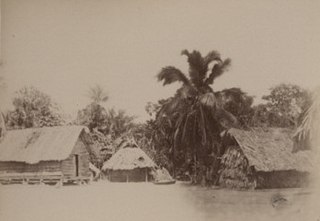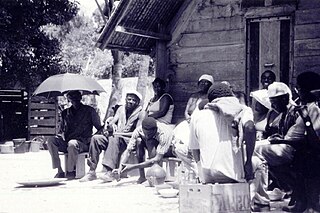Villages
The Kwinti are in a minority in the following villages: [29]
| Total population | |
|---|---|
| 1,000 [1] (2014, est.) | |
| Regions with significant populations | |
| Bitagron and Heidoti, Suriname | 300 |
| Languages | |
| Kwinti, Sranan Tongo, Dutch | |
| Religion | |
| Christianity mainly Moravian Church | |
| Related ethnic groups | |
| Saramaka, Matawai, Ndyukas | |
| Granman of the Kwinti people | |
|---|---|
Incumbent Remon Clemens since 2020 | |
| Residence | Bitagron |
The Kwinti are a Maroon people, descendants of runaway African slaves, living in the forested interior of Suriname on the bank of the Coppename River, and the eponymous term for their language, which has fewer than 300 speakers. [2] Their language is an English-based creole with Dutch, Portuguese and other influences. It is similar to the languages spoken by the Aluku and Paramaccan Maroons, [3] and split from Sranan Tongo in the middle 18th century. [4] The Kwinti had a population of about 300 in 2014 [1] and adhere to the Moravian Church. [5]
There are two possible origins of the Kwinti people. One oral account mentions the Berbice slave uprising of 1763 in Guyana, the other mentions a plantation in the Para District. [6] The tribe was initially led by Boku who died in 1765. [7] Boku was succeeded by Kofi, who is claimed to be an brother of Boni. [8] The tribe was known from the early 18th century, and there had been several raids on plantations conducted by the Kwinti. [9]
On 19 September 1762, the Dutch signed a peace treaty with the Saramaka. [10] In 1769, the Matawai split from the Saramaka, and asked the Government for weapons against the Kwinti who had raided the Onoribo plantation in November 1766. [9] During the late 18th century the tribe was attacked many times by either the Matawai or the colonists. [11] In the 1850s, [7] the Kwinti had made a peace treaty with the Matawai granman, and settled among the Matawai in Boven Saramacca. [12] There are currently two villages which are inhabited by both tribes. [13] Another part of the tribe, settled on the Coppename River where they founded Coppencrisie (Coppename Christians). Later the village was abandoned, and the villages of Bitagron and Kaaimanston were established. [14]
During the 19th century the tribe is hardly ever mentioned until a peace treaty with the Surinamese Government is signed in 1887. [11] The treaty appointed Alamun as a head captain and not as a granman . The treaty gives him control over the Kwinti living along the Coppename River, the Kwinti living on Saramacca River remained under the authority of the Matawai. [15] In 1894, the area of control was delimited around Bitagron and Kaaimanston, [15] because of nearby wood and balatá concessions. Also a posthouder (post holder) was installed to represent the government. [16] Until the early 20th century, there used to be a trail connecting both sides, but it had fallen into disuse and was reclaimed by the jungle. [17]
In 1970, when the Dutch government organised a well published tour with the five Surinamese Maroon nations to Ghana and other African countries, the Kwinti were not invited. [18] In 1978, Matheus Cornells Marcus was appointed as head captain in Bitagron. [19] In 1987, during the Surinamese Interior War, Bitagron was partially destroyed during the fighting with the Jungle Commando. [20] Later the other villages were isolated from the outside world by the Tucayana Amazonas. [19] The other villages were in Matawai territory, and under the control of Lavanti Agubaka who was allied with the Tucayana Amazonas. On 30 September 1989, the Kwinti announced that they no longer recognized Lavanti, and demanded a granman for their nation. [19] In 2002, André Mathias was the first tribal chief to rule as granman over all villages except for those where the Kwinti were in a minority; [21] he died in 2018. [22] Remon Clemens was named as granman in 2020. [23]
The traditional religion of the Maroons is Winti. In the shared area with the Matawai, the Moravian Church had been highly successful after Johannes King, a Matawai, became their first Maroon missionary. [24] The Moravian Church operated a mission in Kaaimanston, [25] and in the 1920s, the Catholic Church started missionary activities in the Coppename area. [26]
The Kwinti are in a minority in the following villages: [29]

The Aluku are a Bushinengue ethnic group living mainly on the riverbank in Maripasoula in southwest French Guiana. The group are sometimes called Boni, referring to the 18th-century leader, Bokilifu Boni.

The Paramaccan or Paramaka are a Maroon tribe living in the forested interior of Suriname, mainly in the Paramacca resort, and the western border area of French Guiana. The Paramaccan signed a peace treaty in 1872 granting the tribe autonomy.
Witagron is a Kwinti village in Suriname on the Coppename River at the crossing of the Southern East-West Link from Paramaribo to Apoera in West-Suriname.
Pakka-Pakka or Pakkapakka, also Pakkapakka 1 and Pakkapakka 2, is a Maroon village in the rainforest of Boven Saramacca resort in Sipaliwini District in Suriname. The village is inhabited by Matawai people. The village was founded in the 1860s and was originally home to both Matawai and Kwinti people.
Heidoti is a village in Boven Saramacca municipality (resort) in Sipaliwini District in Suriname. Heidoti is home to Maroons of the Kwinti tribe.

Boven Saramacca is a resort in Suriname, located in the Sipaliwini District. Its population at the 2012 census was 1,427. The dominant geographical feature of this resort is the Saramacca River. The resort is mainly inhabited by Maroons of the Matawai tribe.

Boven Coppename is a resort in Suriname, located in the Sipaliwini District. Its population at the 2012 census was 539. The resort is mainly inhabited by indigenous people of the Tiriyó, and Maroons of the Kwinti tribe. The main village is Bitagron. Other villages include Corneliskondre and Donderskamp.

The Ndyuka people or Aukan people (Okanisi), are one of six Maroon peoples in the Republic of Suriname and one of the Maroon peoples in French Guiana. The Aukan or Ndyuka speak the Ndyuka language. They are subdivided into the Opu, who live upstream of the Tapanahony River in the Tapanahony resort of southeastern Suriname, and the Bilo, who live downstream of that river in Marowijne District

Afro-Surinamese are the inhabitants of Suriname of Sub-Saharan African ancestry. They are descended from enslaved Africans brought to work on sugar plantations. Many of them escaped the plantations and formed independent settlements together, becoming known as Maroons and Bushinengue. They maintained vestiges of African culture and language. They are usually split into two ethnic subgroups.
Kwinti is an English-based creole of Suriname closely related to Ndyuka. The language has less than 300 speakers, and split from Plantation Creole which is nowadays known as Sranan Tongo in the middle 18th century. Code-switching with Sranan Tongo and Dutch was common among the younger generation in 1973, and about 70% of the tribe have moved to the urban areas. UNESCO considers the language endangered.

Surinamese Maroons are the descendants of enslaved Africans that escaped from the plantations and settled in the inland of Suriname. The Surinamese Maroon culture is one of the best-preserved pieces of cultural heritage outside of Africa. Colonial warfare, land grabs, natural disasters and migration have marked Maroon history. In Suriname six Maroon groups — or tribes — can be distinguished from each other.

Santigron is a Maroon village in Lelydorp, Suriname. The village of Santigron is along the Saramacca River not far from Paramaribo. It is one of Suriname's Maroon villages, where descendants of 18th Century run-away slaves live. Unlike in Brazil or Jamaica, some 20,000 Maroons are still living in Suriname 's rainforest and retain many aspects of their traditional Afro-American culture. The village was founded by Jajasie Adoemakeë in the middle of the 19th century. Adoemakeë started working at a nearby wood plantation, and claimed to have received ownership after the plantation owner died in 1861, however the deed was lost.

Granman is the title of the paramount chief of a Maroon nation in Suriname and French Guiana. The Ndyuka, Saramaka, Matawai, Aluku, Paramaka and Kwinti nations all have a granman. The paramount chiefs of Amerindian peoples in Suriname are nowadays also often called “granman”.

The Matawai are a tribe of Surinamese Maroons. The Matawai were originally part of the Saramaka, and signed a peace agreement with the Dutch colonists in 1762. The tribe split from the Saramaka, and in 1769, they were recognized as a separate tribe.
Bokilifu Boni was a freedom fighter and guerrilla leader in Suriname, when it was under Dutch colonial rule. Born in Cottica to an enslaved African mother who escaped from her Dutch master, he grew up with her among the Maroons in the forest. He was such a powerful leader that his followers were known as Boni's people after him. They built a fort in the lowlands and conducted raids against Dutch plantations along the coast. Under pressure from Dutch regular army and hundreds of freedmen, they went east across the river into French Guiana. Boni continued to conduct raids from there, but was ultimately killed in warfare.
The Brooskampers were a Maroon people, descendants of runaway African slaves, living in the forested interior of Suriname. The tribe is related to the Saramaka, and originated from Loango-Angola. The Brooskampers gained autonomy in 1863, but sold their land in 1917.

Maripaston was a village in the Bigi Poika resort of the Para District, Suriname. The village was located along the Saramacca River and used to be the main village of the Matawai maroons.
Pikin Saron is an indigenous village of Kalina Amerindians in the resort of Zuid in the Para District in Suriname. The village can be accessed from the Southern East-West Link, and is located on the Saramacca River.
Saramaka is a neighbourhood of Kourou, French Guiana. The neighbourhood is mainly populated by Saramaka maroons from Suriname who settled in the area during the construction of the Guiana Space Centre.

Diplomatic relations between France and Suriname were established on 25 August 1976. Suriname and the French overseas department of French Guiana share a common border of 520 kilometres (320 mi). Suriname operates an embassy in Paris, a consulate in Cayenne, and an honorary consulate in Saint-Laurent-du-Maroni. France operates an embassy in Paramaribo, a consulate in Georgetown, Guyana, and an honorary consulate in Albina.